
Spring is right around the corner, and now is the perfect time to start repotting your houseplants. When you repot your houseplants in the Spring, you are giving them more room to grow in the active growing seasons. By repotting your plants, the right way, you are setting them up to grow big and strong!
This post may contain affiliate links. Please see my disclosure policy.
Every year around March, I go around the entire house and figure out which plants need to be repotted. I mark them by sticking a toothpick in the soil, just so I don’t forget. Then I go around and make a list of which size pots I’ll need for those plants. After I’ve gathered my pots, it’s time to repot. Keep reading for tips on how to know if your plants need repotting.
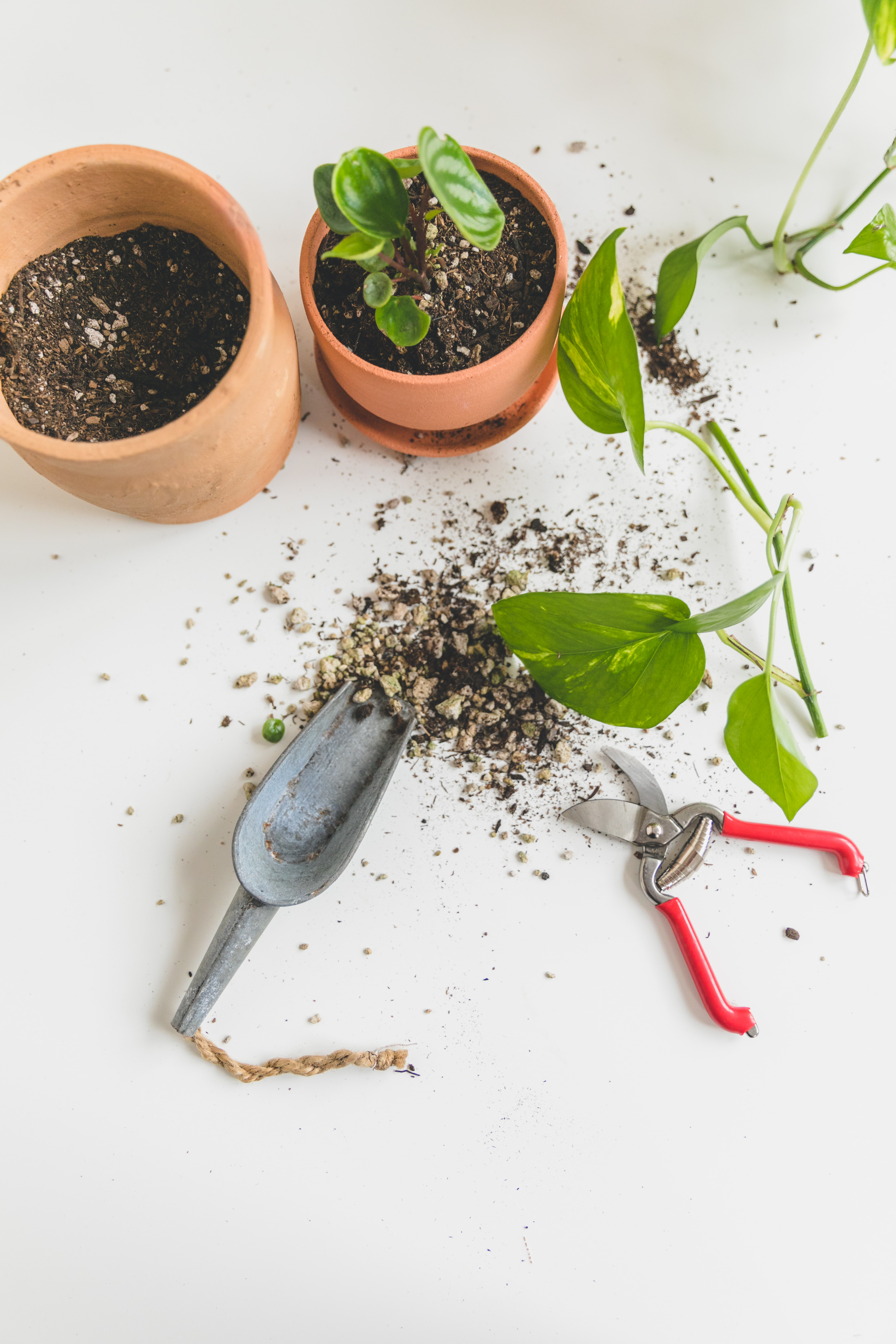
How do I know when it’s time?
In general, plants will exhibit signs. If you see root exposed on the top of the soil or growing out the drainage hole, it’s time to repot! You can also hold the plant on its side and gently pull out the plant. If the roots are coiled up around the bottom and the whole thing comes out of the pot easily, it’s time! One other way is if you notice the plant hasn’t grown in a while or it’s been in the same pot for 2-3 years, its probably time.
Watch how I repot, on AM Northwest!
When do I repot?
The best time to repot is in the spring. Most plants are starting to actively grow in the spring and will need the room to grow big and strong!
Pro Tips
- You’ll want to use a pot no larger than 3″ bigger around the entire root system of the plant.
2. If you are repotting a new plant that you just brought home from the store (still in plastic container), wait at least a week or two. It will need to acclimate to its new environment and then you can repot.
What kind of pot do I use?
There are a ton of beautiful pots out there! I love terracotta and talk about why, here. The one thing I can’t stress enough, is buying a pot that has a drainage hole. If you have to buy the beautiful pot with no hole, plant your houseplant in plastic container with drainage holes and place it inside the other one. Use the decorative pot as a cache pot. You can also drill a drainage hole in your container, here’s how! Not having drainage in place is a bad idea. Save yourself some time and heartache by potting your plant in a vessel with drainage to begin with!
What kind of soil do I use?
The best thing to do is ask someone at your local nursery. Tell them what you are planting and they’ll give you suggestions. If it’s a tropical houseplant, I’ll use an organic indoor potting soil. I often amend the soil with orchid bark and/or perlite. If you’re repotting a succulent or cactus, you’ll need a soil with better drainage. Typically amended with pumice, vermiculite, or perlite.
What do I need?
-Potting soil
-New pot
-Root bound plant
-Small shovel (cup or your hands) for shoveling dirt
-A bit of water
-Clean scissors (If you need to trim roots)
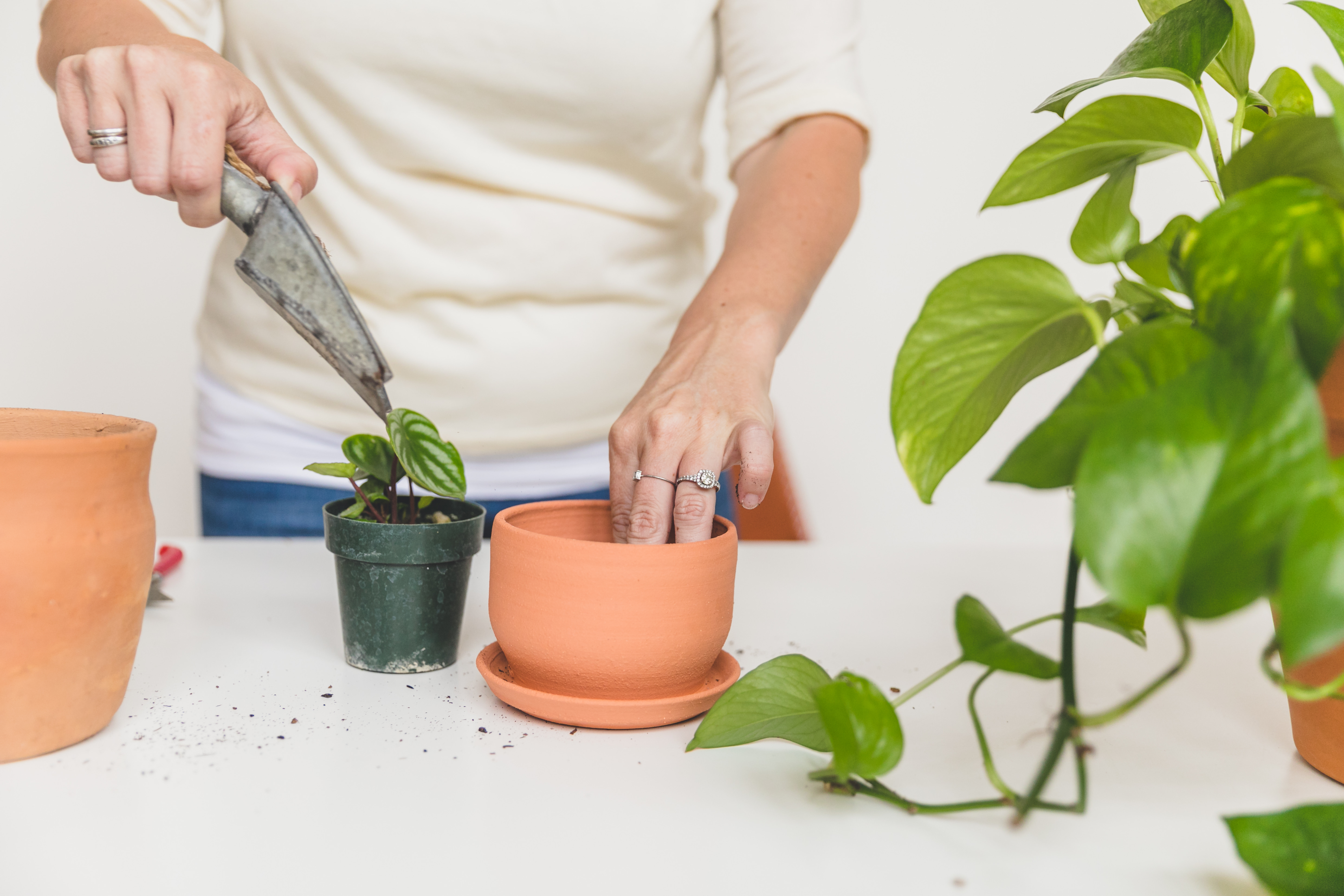
Let’s get started!
-Wash your pot before repotting. (Especially if you are using an old pot)
-If possible, water the plant in it’s current container a few hours prior. This will help loosen the soil and the roots. For larger plants it’s good to water 24 hours in advance.
-Create a workspace for you to get messy!
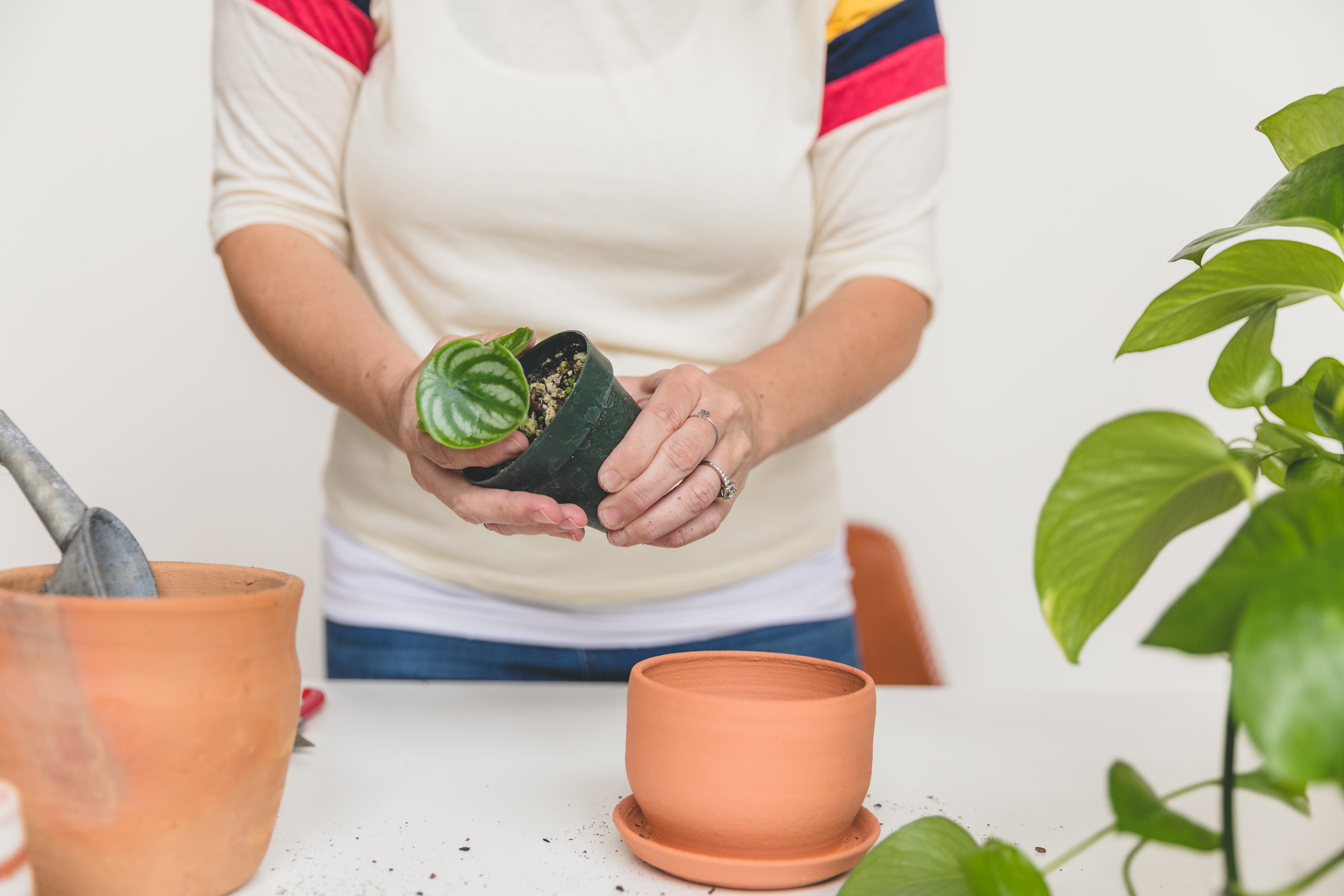
Step by Step
- Gently take the plant out of its current container. You can lightly pull the bottom of the plant as you hold the container on its side. Tap tap tap!!!
- Loosen the dirt and gently massage the roots out of the coil. Trim roots if needed.
- Place a layer of soil at the bottom of the new pot. About 1″-3″ will do (but every pot is different).
- Place your plant inside the pot in the center and fill the sides of the pot with soil. Press firmly to push soil down but do not pack it too tight. If desired, add Systemic Insect Control as directed. I do this with ALL my plants.
- Water the soil evenly until the water starts to drain out of the hole.
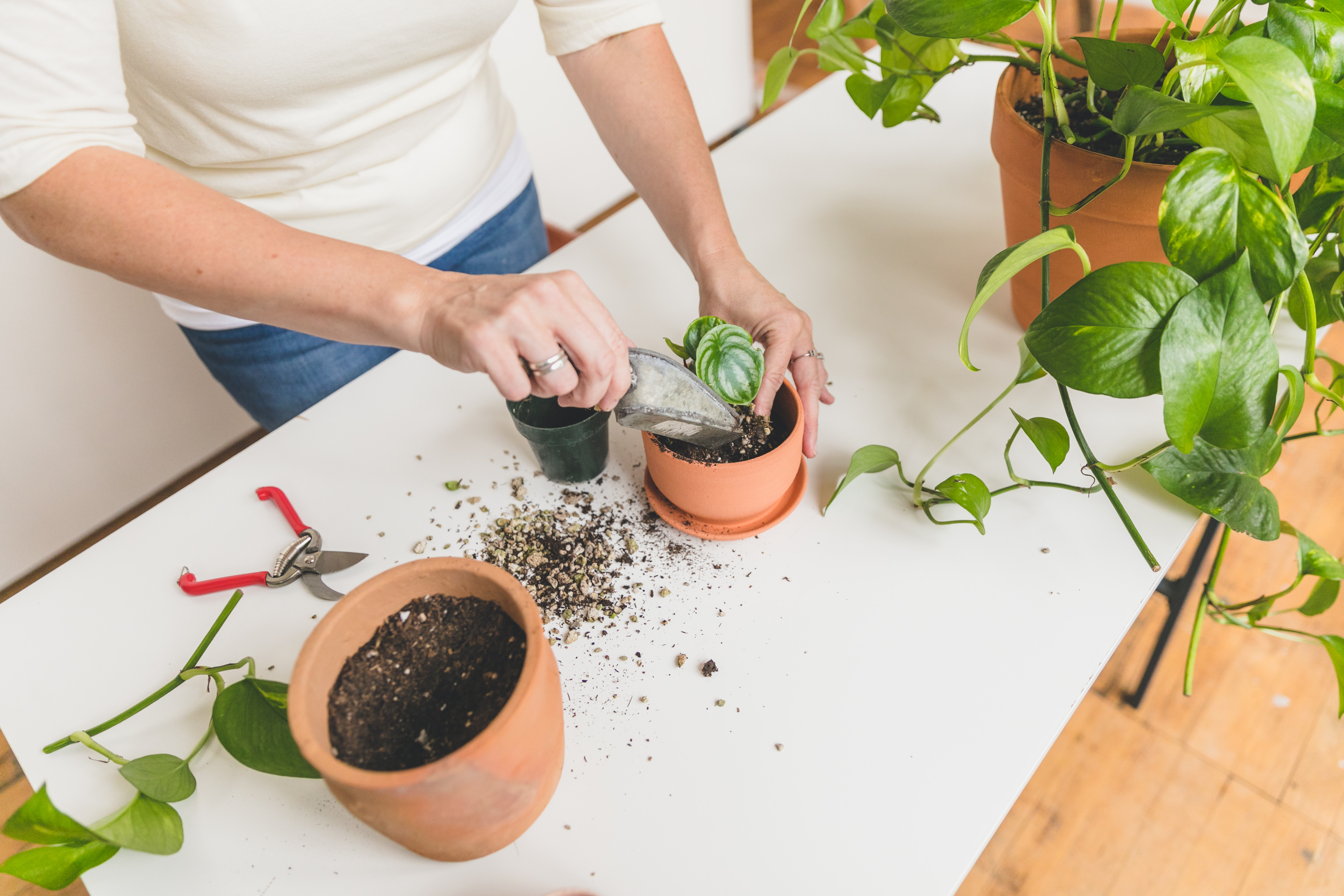

I hope this post was helpful for you! If you have questions, leave a comment and I’ll answer them the best I can. Don’t forget your local nursery is a great source of knowledge. Head over to My IG where I share daily plant inspiration!! Happy repotting!
Repin for later!
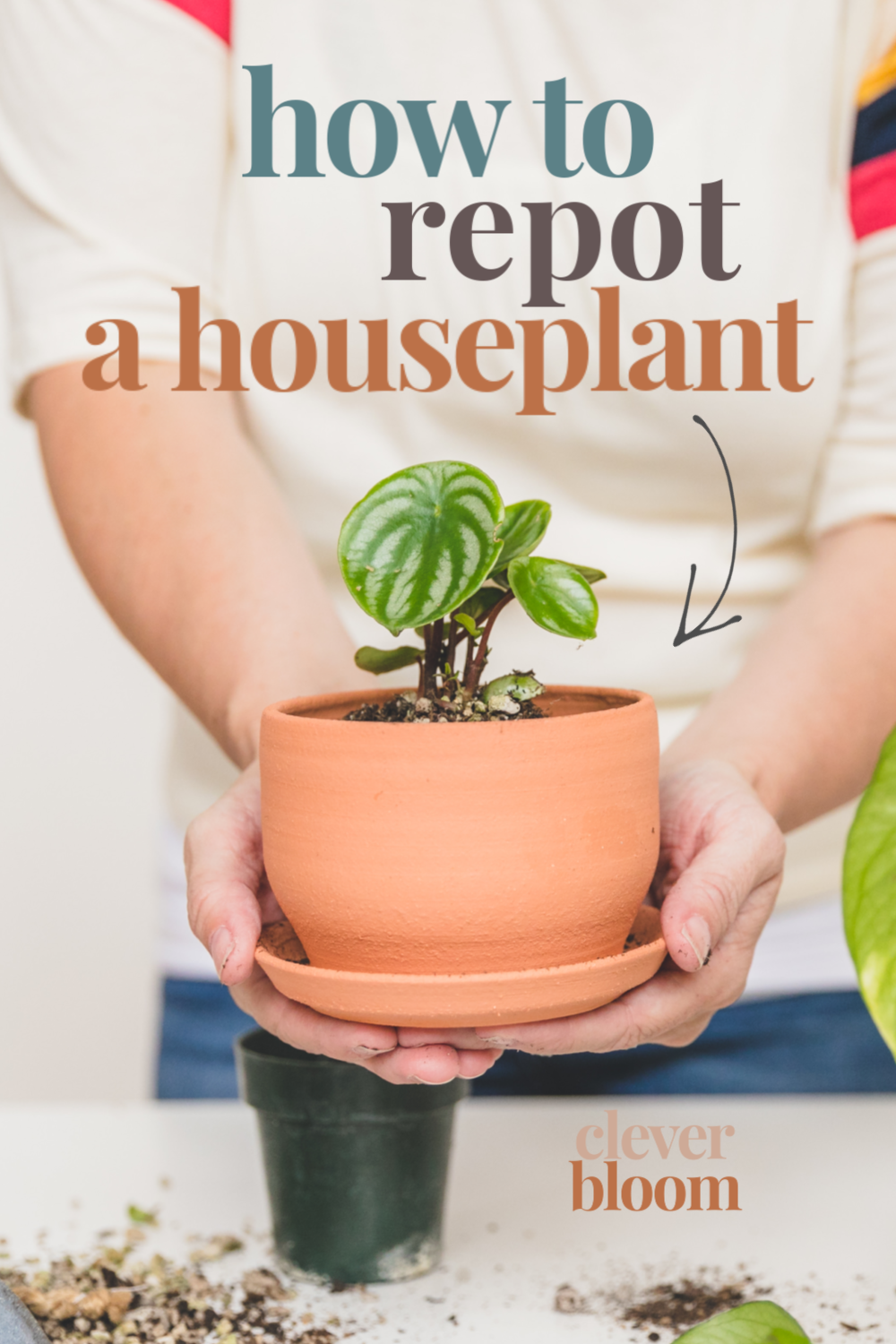

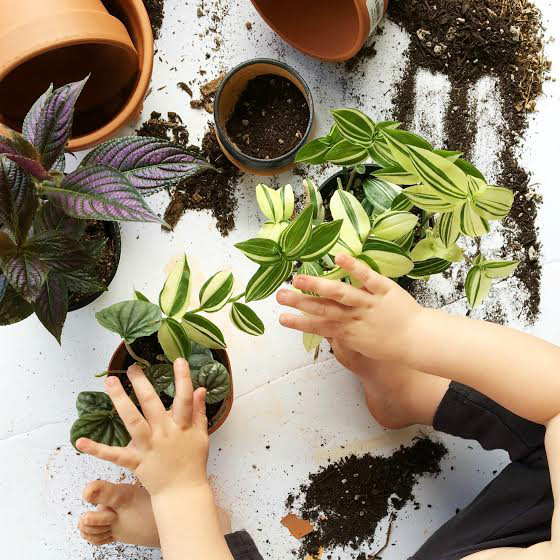
Hi Erin! Thanks for the tips. I was curious if you ever had a problem with small flies (I guess they’re gnats) coming from the plants themselves.
Thanks 🙂
I see gnats off and on. They will eat plant roots. To help, keep a fan circulating air and sprinkle Diatomaceous Earth on top of soil infested with gnats (this tip was shared with me by a wholesaler for Home Depot here in AZ).
I had the same problem for months with an aloe I bought. I kept the soil as dry as I could without killing the plants (knots thrive in moisture as do their eggs, which they lay on top of soil) and used Diatomaceous earth as Lisa recommends. It took awhile but I did get rid of them and my plant was fine. I also separated the infested plant from my others. Also a water down solution of hydrogen peroxide sprayed on top of soil could help but depends on plant possibly. I didn’t find that this worked much for me though:)
Hi Erin. My name is Sarah. I m from NYC .. I have a craze for houseplants, but sadly whenever i bring a new plant whether in summer or winter ,it doesnt survive for so long . Here temp is dry .as the homes r centrally heated cz of freezing weather most of the time a year..so how can I make my plants survive and how i can nourish them healthy and green ??
Thanks so much for the tips on re-potting house plants. I have a few new shrubs I just got, but I’m not happy with the pots they came in. I like that you suggest adding about 1-3 inches of soil in the bottom of the new pot. This would definitely make up for any lost soil when transferring it.
Thanks for the tips. I appreciated understanding what I’m doing right. ?
Yessss thank you so much! Your writing is delightful and your advice is much needed (and appreciated).
Hi,
My question is, How do I know when it is time to put a plant that I have been growing in water and now have roots in it a pot with soil.
Hey Tanya! That’s my question too! I hope you get an answer soon cuz I’m in need too! I put a yam in water with my grandson using toothpicks to hold it up and for our second project we cut tops of a “leggy” plant. They’re both getting roots, and the yam has tiny leafs or are little leafs called leaflets…. haha. When do I give them soil?
Terri in Vegas
Hi!! So it’s up to you. Many plants can stay rooting in water for a long time but I suggest putting them in soil once they around 4”-6” long! Hope that answers your question!
Hi, Erin,
I have many philodendron cuttings that I have been rooting in water, some for FIVE years! They are full and lush and have done very well but I now want to pot some of them. Of course, the roots of the oldest cuttings are very long. When I trim them, how long should I leave roots?
Hi, what is the name of the plant that you are re-potting in this demo? Or does anyone know? Thanks so much!
Spider plant 🙂
It’s actually a watermelon peperomia. They resemble the fruit.
They’re referring to my old photos. I just updated them to this watermelon peperomia. They used to be spider plant photos ?
It really helped when you said to buy a pot that has a drainage hole. I’ve been wanting to get more house plants for my kitchen and I’m not sure which ones to get. Thanks for the tips and I’ll be sure to find a pot and plant that I know how to take care of how much to water it.
Thanks for explaining that we should start by putting 1-3 inches of soil at the bottom of the new pot for our plant. My neighbor just moved and gave us a few of her houseplants, some of which look pretty cramped and probably need to be repotted. I appreciate you sharing these tips I can use after I buy the soil and supplies I need for repotting!
I followed it after reading…it’s really useful and great ! I also advised my family members about it. Thanks a lot to this website !
My money tree plant came in pot with no draining holes…should I repot the plant to a pot with holes? How much water do I give my money tree plant or do I use ice cubes? Tree is small.